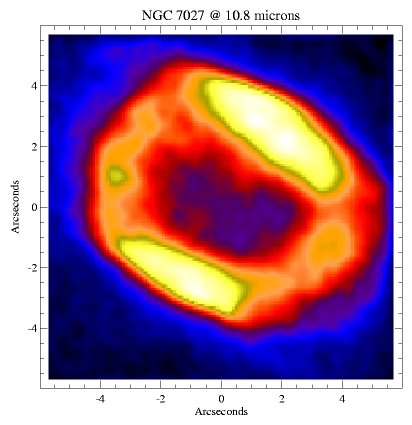| |
Summary of OSCIR Engineering/Commissioning (June
2000)
|
OSCIR, the visiting University of Florida 10um imager and spectrograph, has just
completed its first commissioning run on Gemini North. This period saw several engineering
firsts for Gemini: the first use of chopping synchronised to an instrument, the first test
of the Visitor Instrument Interface (used to exchange commands and status information
between OSCIR and the Telescope Control System), the first chopping and nodding of the
telescope, the first attempts at simultaneous chopping and fast guiding and, of course,
the first 10um images.
| The image (at right) is of the young planetary nebula NGC7027 and consists
of 1 minute chopped integration using a 10 arcsec chop throw at 3Hz taken through the
broad-band 10um filter. It has been smoothed with a 3 pixel (0.26 arcsec) Gaussian. The
excellent image quality is evident, for example, in the emission peak to the far left
(north-west on the sky) that has a full-width at half maximum of slighly less than 0.4
arcsec. The bulk of the emission in this waveband is from dust particles and large
hydrocarbon molecules, which can only survive outside of the ionized central region. There
is also some emission from ionized atoms within the hot central region.
Planetary nebulae are large luminous shells of material ejected from dying stars. The
material of this particular PN was ejected about a thousand years ago and is currently
about 100 times the size of our Solar System. |
 |
Some notable results from this highly successful engineering run include:
- The sensitivity at in the N (broad-band 10um) filter is likely to be better than
advertised (i.e. preliminary 5sigma 1hr for a point source of 0.6mJy). Data were collected
in each of the OSCIR filters and will allow an update the table of sensitivities ahead of
the next call for proposals.
- Diffraction-limited image quality was demonstrated in broad and narrow-band filters in
short exposures. Measurement of the image size (whilst chopping) gave FWHM of 0.25 and
0.35 arcsec at 7.8 and 12.5um, respectively, under light-winds. There is some work
remaining to enable reliable fast guiding while chopping which is required to deliver good
image quality during long integrations.
- Very low residual background (also known as "radiative offset"), and with no
significant gradient, in chopped difference images. This implies that low, uniform
telescope background and good thermal uniformity have been achieved. Quantitative
measurements of the system emissivity will be made during the next OSCIR run.
We are extremely grateful for the hard work put in by the OSCIR team (Charlie Telesco,
Robert Pina, Kevin Hanna, Jeff Julian, Scott Fisher, Chris Packham, Naibi Marinas and
David Ciardi), Chris Mayer (Observatory Sciences Ltd., for the VII) and the Gemini support
staff.
![[Science Operations home]](../../generic-images/sciopshomebtn.gif)
![[OSCIR home]](oscirhomebtn.gif)
Last update July 5, 2000; Phil Puxley
